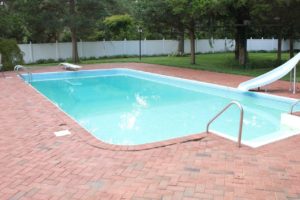Pool Cleaning
 Even though you may see your in-ground backyard swimming pool as a hole in the ground that you keep shoveling money into, over time, it will accumulate dirt and debris on the bottom and sides and you will need to vacuum it to clean it. This is easy to do with a pool brush and vacuum head, a vacuum hose, and a telescopic pole. Before you get started, you need to make sure that the filtering system is working properly. You can check the pressure gauge on your pool’s filter to see if it is higher than normal and has meaning it has accumulated sediment and needs to be backwashed. However, just to be on the safe side, backwash your filter using the multiport valve and a backwash hose to purge the filter and get it back to the optimum operating pressure.
Even though you may see your in-ground backyard swimming pool as a hole in the ground that you keep shoveling money into, over time, it will accumulate dirt and debris on the bottom and sides and you will need to vacuum it to clean it. This is easy to do with a pool brush and vacuum head, a vacuum hose, and a telescopic pole. Before you get started, you need to make sure that the filtering system is working properly. You can check the pressure gauge on your pool’s filter to see if it is higher than normal and has meaning it has accumulated sediment and needs to be backwashed. However, just to be on the safe side, backwash your filter using the multiport valve and a backwash hose to purge the filter and get it back to the optimum operating pressure.
To get things started, you need to attach the vacuum head to the telescopic pole that has fittings on one end that are designed to mate to the head.
The telescopic pole is an extendable pole that connects to various pool maintenance attachments. The vacuum head will have a fitting that the end of the pole fits over, inside this cylindrical fitting is a flexible plastic y shaped piece each end having a round button on it. The pole has 2 holes corresponding to these buttons so that when you push the pole over the fitting on the vacuum head and depress the buttons you are able to slide the pole over the fitting and the buttons engage the 2 holes in the pole and the connection is made. The fitting is connected to the vacuum head by a plastic pin that allows it to pivot about 120 degrees so that the head stays flush to the pool’s bottom no matter the angle. At the beginning of the season a few problems can develop here. First, the pin can break or go missing, second the y shaped clip can break or go missing and finally the ears on the fitting that connects to the vacuum head can break. Any, or all, of these will put an end to your project. The solution is to plan ahead and keep a small quantity of these on hand because at the beginning of the season when you are having this problem, everyone else is too. These parts are economical and are available on Amazon from Tech Team Products https://techteamproducts.com/product-category/around-the-home/
https://www.amazon.com/dp/B08FKDYVH1?ref=myi_title_dp https://www.amazon.com/dp/B08FK6DZ7C?ref=myi_title_dp https://www.amazon.com/dp/B08FK3N261?ref=myi_title_dp
Make sure the hose is long enough that you will be able to walk around the perimeter of your pool and cover all the surface area of the bottom of the pool.
A pool vacuum head is a simple part that has a fitting to connect a pole and a cylindrical nipple for the hose that sticks up from the head that you push the hose onto. Once you connect the hose make sure the hose is long enough that you will be able to walk around the perimeter of your pool and cover all the surface area of the bottom of the pool. Now prime the hose by holding the pole and extend it so it is long enough to reach the bottom and push the vacuum head down slowly into the pool until it reaches the bottom. Start at a part of the pool near a return jet and place the open end of the hose over the jet so it covers the jet stream. Watch the bubbles coming up from the vacuum head at the bottom of the pool and remove the hose from the jet when bubbles stop. Keep the open end of the hose in the water yet or you might end up losing the prime. Take the basket out of the skimmer and this will expose the skimmer’s suction hole that you need to use to vacuum your pool. Now attach the skimmer vacuum plate to the open end of the hose. This is a plate that is specifically designed to go on the end of the hose and then cover the pool skimmer’s suction hole to make a secure connection. If there is a second skimmer, make sure that it is blocked so that you get maximum suction. Now, with the filter running and set to the filter setting, place the vacuum plate over the hole in the bottom of the skimmer and you are ready to start. The suction will hold the vacuum plate in place. Go slow and steady so you don’t stir up debris and overlap your strokes, so you don’t miss any sections. If you start kicking up clouds up the water, stop and wait for 1-2 hours to let the debris settle before continuing to vacuum.
Take note of the pressure on the filter’s gage before you start to vacuum. If it rises more than 5-8 psi, stop and backwash the filter before continuing.
